What Exactly Is Caster Sugar? Plus, How You Can Make It at Home.
You might think of sugar as a pretty simple baking ingredient. Most American recipes call for granulated sugar. However, there are many types of sugar available on shelves today. In addition to brown sugar, sanding sugar, powdered sugar, and turbinado sugar, you might come across recipes that call for caster sugar.
Caster sugar, also spelled as castor sugar in the United Kingdom, Australia, and New Zealand, is also sometimes referred to as superfine sugar or baker’s sugar. Read on to learn more about what makes caster sugar unique, where to buy it, how to use it, and how to substitute for it.
What Is Caster Sugar?
Caster sugar, available in both white and golden varieties, is a type of sugar with granules that are more fine than standard granulated sugar but less fine than powdered sugar. Caster sugar is made by grinding sugar granules to create a softer and more fine texture. The name comes from a caster sugar container, which has very small holes through which the sugar can be sifted over food and drink. White caster sugar is refined, while golden caster sugar is made from unrefined sugar cane and, as the name implies, has a golden-brown hue.
Where to Buy Caster Sugar
Caster sugar can sometimes be found labeled as superfine sugar in the baking aisle of regular grocery stores, but if you can’t find it at your supermarket, try a specialty baking store like Sur La Table. You can also find it online from sources like Amazon and Walmart.
What Is a Substitute for Caster Sugar?
If you stumble upon a recipe that sounds good but calls for caster sugar and you don’t have access to it, don’t worry. “In most instances caster sugar can be used interchangeably (by weight) with granulated sugar,” says Kierin Baldwin, chef and baking instructor at The Institute of Culinary Education.
As Baldwin notes, the most accurate way to substitute granulated sugar for caster sugar is by weight using a kitchen scale. “Caster sugar is the same by weight as granulated, because the sugar part of what you’re weighing weighs the same whether it’s big crystals or small,” explains Baldwin. “So 225 grams of caster sugar is the same amount as 225 grams of granulated.” However, if you don’t have a kitchen scale, you can approximate by volume. “Thankfully sugar weighs around 200 grams per cup, meaning that 225 grams of caster sugar would be equal to about 1 cup plus 2 tablespoons of granulated,” says Baldwin.
There are some cases when you should seek out caster sugar (or make it at home — more on that below). “Whenever I’m trying to dissolve sugar in a liquid that is not warm, I’ll use caster sugar, since it will dissolve more easily because of its smaller crystal size,” says Baldwin. So for things like drinks, syrups, meringues, and whipped cream that require dissolving sugar quickly and with little to no heat, caster sugar can come in handy.
How to Make Caster Sugar
To make caster sugar at home, you can simply pulse granulated white sugar in a food processor for about 30 seconds. Baldwin advises starting with slightly more sugar than your recipe calls for to ensure you have enough to work with.
